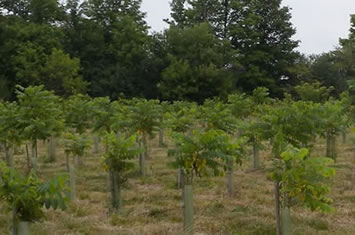Forests are climate sensitive, and a range of climate change impacts are already evident across Canada. Trees appear to be responding to warming temperatures by dispersing into more climatically suitable habitats. However, some populations will be unable to keep up with the rapid rate of environmental change.
Numerous adaptation options are being considered as ways to maintain the biodiversity, health and productivity of Canada’s forests under continued climate change. One option that is of increasing interest is “assisted migration,” the human-assisted movement of plants or animals to more climatically suitable habitats.
In order to ensure that seeds used in reforestation are adapted to their environment, many jurisdictions have developed seed transfer guidelines that recommend where seed from specific geographical areas should be planted. Some jurisdictions in Canada have begun to implement assisted migration of tree species on a small scale by modifying these guidelines. For example, British Columbia has extended seed transfer zones 200 metres higher in elevation for most species, and introduced new policy to allow the planting of western larch outside of its previous range. Alberta has extended seed transfer zones 200 metres higher in elevation and 2 degrees of latitude northward for most species. And Quebec has incorporated the risk of climate change maladaptation into seed transfer functions, planting seed mixtures composed of local and more southern seed sources in some regions. In all cases, it is critically important that the seed used in assisted migration has been documented, tested and stored appropriately, and has come from a wide range of sources and species.
Assisted migration can be contemplated for both conservation goals (e.g., to save a species) and forestry goals (e.g., to maintain health and productivity). Currently, given existing knowledge and established best practices, assisted migration is more feasible for major commercial tree species than for rare species of conservation concern.
Issues to be considered
Assisted migration has the potential to alleviate some of the risks posed by climate change to biodiversity and tree health and productivity, such as species extinction. However, there are possible risks in implementing assisted migration. These might include the impact of the introduced species on the hosting environment, a species becoming invasive, mortality and investment loss if the species or population is not well adapted to the local conditions, and so on. These risks must always be balanced against the risk of not doing it.
Assisted migration describes a wide range of concepts and practices at various scales. But three types of assisted migration, each with a different level of risk and uncertainty, can be distinguished:Footnote1
- Assisted population migration—The human-assisted movement of populations within a species’ established range—Lower risk
- Assisted range expansion—The human-assisted movement of species to areas just outside their established range, facilitating or mimicking natural range expansion—Intermediate risk
- Assisted long-distance migration—The human-assisted movement of species to areas far outside their established range (beyond areas accessible through natural dispersal)—Higher risk
In order to ensure that assisted migration is beneficial and that the risks are minimized, decisions need to be supported by the best possible scientific knowledge. A range of dimensions other than climate, such as photoperiod and soil properties, will need to be considered when deciding what species to move and where to move it to. Where assisted migration is undertaken, migrated populations and the receiving ecosystems should be carefully monitored over time.
Assisted migration is an emerging concept with potential benefits as a climate change adaptation strategy but it poses many questions and offers many unknowns. The idea that humans can help fill the gap between the ability of species to migrate and the rate of change in climate conditions is increasingly being considered and debated as a possible management option.
The Canadian Forest Service is expanding knowledge of assisted migration on several fronts, including research aimed at filling knowledge gaps, development of practical research tools and models, and the conservation of vulnerable species, in addition to collaborating with national and international entities.

The photo shows black walnut trees in the middle of their third growing season.
Assisted migration trial
In an assisted migration trial in Claremont, Ontario, led by Natural Resources Canada and the Ontario Ministry of Natural Resources, six hardwood species were gathered from four different seed sources and replicated five times. Species and seed sources were selected from locations approximately 500 (Pennsylvania), 900 (Kentucky) and 1,400 (Tennessee) kilometres south of the Claremont planting site, using one local seedzone as a control. Trials such as these and older forest genetics trials are increasingly being used to help address the many questions raised by assisted migration.
- Placing forestry in the assisted migration debate
- Chasing climate change. Exploring the option of assisted migration
- Assisted migration: Introduction to a multifaceted concept
- Ecological implications for assisted migration in Canadian forests
- Review of science-based assessments of species vulnerability: contributions to decision-making for assisted migration
- Why we disagree about assisted migration: ethical implications of a key debate regarding the future of Canada's forest
- The implementation of assisted migration in Canadian forests
- More research